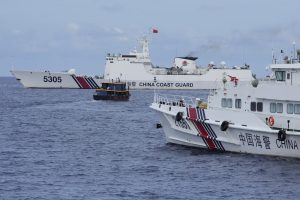The Philippines and the United States have started joint air and sea patrols in the South China Sea, the latest step in the two allies’ response to China’s growing assertiveness in contested waters.
The three-day drills began yesterday in waters near Mavulis island, the Philippines’ northernmost point, which is located around 100 kilometers from Taiwan, Eugene Cabusao, spokesperson for the Northern Luzon command, told the press. They will then conclude in the West Philippine Sea, as the Philippines refers to its portion of the South China Sea, which has seen a rash of recent confrontations between Chinese and Philippine vessels.
In a statement, Philippine President Ferdinand Marcos Jr. said that the three-day joint air and maritime exercise was a “significant initiative” that would further boost interoperability between the two nations’ militaries.
“Through collaborative efforts, we aim to enhance regional security and foster a seamless partnership with the United States in safeguarding our shared interests,” he said. “I am confident that this collaboration will contribute to a more secure and stable environment for our people.”
The Philippine military said that three Philippine navy ships, two FA-50 light combat aircraft, and an A-29B Super Tucano light attack plane would take part in the joint patrols. The U.S. has sent a littoral combat ship and a P8-A Poseidon maritime patrol and reconnaissance aircraft.
Marcos’ announcement of the joint patrols, which has been expected for some time, came a day after he visited the U.S. Indo-Pacific Command in Hawaii and gave a speech to a think tank in Honolulu in which he said that the situation for the Philippines in the disputed waterway “has become more dire” due to growing Chinese assertiveness.
Since Marcos took office in July of last year and particularly since the beginning of 2023, China has ramped up its efforts to assert and defend its maximalist “nine-dash line” claim, which bisects a large part of the Philippines’ Exclusive Economic Zone (EEZ).
A particular flashpoint has been Second Thomas Shoal, a submerged feature within the Philippines EEZ, where Manila maintains a small contingent of troops aboard the BRP Sierra Madre, a grounded warship. In recent months China has begun an informal blockade of the shoal, attempting to prevent the Philippine Navy from resupplying its outpost. This has resulted in a number of confrontations, including one last month in which Chinese vessels collided with a Philippine supply ship and navy vessel. Chinese vessels have also used high-powered water cannons and a military-grade laser to drive away Philippine supply flotillas.
The Chinese actions are both a result and cause of the growing security cooperation between the Philippines and the U.S., whose long-time alliance fell largely into abeyance under Marcos’ erratic predecessor, Rodrigo Duterte. Under Marcos, the Philippines has expanded U.S. access to its military facilities, and Washington has been vocal in its support of the Philippines in its stand-offs with China. Washington has since reaffirmed that it is treaty-bound to defend the Philippines in case of an armed attack on any of its forces in the South China Sea.
Marcos has stated that the Philippines’ maritime disputes with China should not be seen through the lens of U.S.-China competition. He has also met twice now with China’s leader Xi Jinping, most recently last week, and pledged to take action to reduce tensions. At the same time, the Marcos administration has not relied on Chinese promises and has taken actions within its power to enhance its deterrence.
Many questions about the growing U.S.-Philippine security patrols remain, such as how frequently they will take place and how they might approach the flashpoint around Second Thomas Shoal. But as Jay Batongbacal, director of the Institute for Maritime Affairs and Law of the Sea in Manila, told Reuters, the Philippines under Marcos “is really firming up its posture on West Philippine Sea issues.”

































